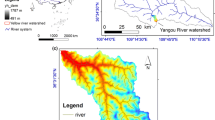Abstract
Natural resource lands in the Chesapeake Bay watershed are increasingly susceptible to conversion into developed land uses, particularly as the demand for residential development grows. We assessed development pressure in the Baltimore-Washington, DC region, one of the major urban and suburban centers in the watershed. We explored the utility of two modeling approaches for forecasting future development trends and patterns by comparing results from a cellular automata model, SLEUTH (slope, land use, excluded land, urban extent, transportation), and a supply/demand/allocation model, the Western Futures Model. SLEUTH can be classified as a land-cover change model and produces projections on the basis of historic trends of changes in the extent and patterns of developed land and future land protection scenarios. The Western Futures Model derives forecasts from historic trends in housing units, a U.S. Census variable, and exogenously supplied future population projections. Each approach has strengths and weaknesses, and combining the two has advantages and limitations.
Similar content being viewed by others
References
Bockstael, N.: (1996) 'Modeling Economics and Ecology: the Importance of a Spatial Perspective', Amer. J. Ag.Econo. 78 (5), 1168-1180.
Boesch, D.F. and Greer, J.: 2003, 'Chesapeake Futures: Choices for the 21st Century', Chesapeake Research Consortium, Inc., Edgewater, MD, USA.
Candau J.: 2002, 'Temporal Calibration Sensitivity of the SLEUTH Urban Growth Model', Masters Thesis, Department of Geography, University of California, Santa Barbara, CA, USA.
Chesapeake Executive Council: “Chesapeake 2000” (2000). 18 June 2003. <http:// www.chesapeakebay.net/agreement.htm>
Clarke, K.C., Hoppen, S., and Gaydos, L.: 1997, 'A Self-Modifying Cellular Automaton Model of Historical Urbanization in the San Francisco Bay Area', Environ. Plann. B: Plann. Des. 24, 47-261.
Clarke, K.C. and Gaydos, L.J.: 1998, 'Loose-Coupling a Cellular Automaton Model and GIS: Long-Term Urban Growth Prediction for San Francisco and Washington-Baltimore', Int. J. Geogr. Inf. Sci. 12, 699-714.
Ewing, R., Pendall, R., and Chen, D.: “Measuring Sprawl and its Impact”. (2002). 18 June 2003. <http://www.smartgrowthamerica.com/sprawlindex/MeasuringSprawl.PDF>
Hardie, I., Parks, P., Gottleib, P. and Wear, D.: 2000, 'Responsiveness of Rural and Urban Land Uses to Land Rent Determinants in the U.S. South', Land Econ. 76 (4), 659-673.
Herold, M., Goldstein, N.C. and Clarke, K.C.: 2003, 'The Spatiotemporal Form of Urban Growth: Measurement, Analysis and Modeling', Remote Sens. Environ. 86, 286-302.
Jackson, L.E., Bird, S.L., Matheny, R.W., O'Neill, R.V., White, D., Boesch, K.C. and Koviach, J.L.: 2004, 'A Regional Approach to Projecting Land-Use Change and Resulting Ecological Vulnerability', Environ. Monit. Assess. 94, 231-248.
Jantz, C.A., Goetz, S.J. and Shelley, M.K.: in press, 'Using the SLEUTH Urban Growth Model to Simulate the Impacts of Future Policy Scenarios on Urban Land Use in the Baltimore-Washington Metropolitan Area', Environ. Plann. B: Plann. Des. in press.
Jenks, G.F. and Coulson, M.R.: 1963, 'Class Intervals for Statistical Maps', International Yearbook Cartography. 3, 119-134.
Jones, K.B., Riitters, K.H., Wickham, J.D., Tankersley, R.D., O'Neill, R.V., Chaloud, D.J., Smith, E.R. and Neale, A.C.: 1997, 'An Ecological Assessment of the United States Mid-Atlantic Region: A Landscape Atlas', EPA/600/R-97/130 U.S. Environmental Protection Agency, Office of Research and Development, Washington, DC, USA.
Lucy, W.H. and Phillips, D.L.: 2001, 'Suburbs and the Census: Patterns of Growth and Decline', The Brookings Institution Survey Series, Center on Urban and Metropolitan Policy, Washington, DC, USA.
McCauley, S. and Goetz, S.J.: 2003, 'Mapping Residential Density Patterns Using Multi-Temporal Landsat Data and a Decision-Tree Classifier', Int. J. Remote Sens. 24 (00), 1-19.
SAIC: 2002, 'Methods for Vulnerability Assessment', December 3, 2002 memorandum from M. O'Kicki and R. Fetter to C. Bisland, Chesapeake Bay Program Office, U.S. Environmental Protection Agency, Annapolis, MD, USA.
Silva, E.A. and Clarke, K.C.: 2002, 'Calibration of the SLEUTH Urban Growth Model for Lisbon and Porto, Spain', Comput. Environ. Urban Syst. 26, 525-552.
Smith, A. J., Goetz, S.J., Prince, S.D., Wright, R., Melchoir, B., Mazzacato, E.M. and Jantz, C.A.: forthcoming, 'Estimation of Sub-Pixel Impervious Surface Area Using A Decision Tree Approach, Ikonos and Landsat Imagery', Remote Sens. Environ. forthcoming.
Theobald, D.: “Technical Description of Mapping Historical, Current, and Future Housing Densities in the U.S. Using Census Block-Groups”. (2001a). 10 April 2003. <http:// ndis.nrel.colostate.edu/davet/pubs/block-group-readme.htm>
Theobald, D.: 2001b, 'Land-Use Dynamics Beyond The Urban Fringe', Geogr. Rev. 91 (3), 544-564.
Theobald D.: Personal Communication, 30 June 2003.
Theobald, D.: in press, 'Targeting Conservation Action Through Assessment of Protection and Exurban Threats', Conserv. Biol. in press.
The Urban Institute: 2002, 'Census CD: Neighborhood Change Data Base: 1970-2000 Tract Data', prepared in collaboration with GeoLytics, Inc., Washington, DC, USA.
metadata.html>
USEPA: 2001a, 'What is the State of the Environment in the Mid-Atlantic Region', EPA/903/F-01/ 003, U.S. Environmental Protection Agency, Mid-Atlantic Integrated Assessment, Philadelphia, PA, USA.
USEPA: 2001b, 'A Summary of Models for Assessing the Environmental Impacts of Community Growth and Change', Review Draft EPA/600/R-00/098, U.S. Environmental Protection Agency, Office of Research and Development, Cincinnati, OH, USA.
USEPA: 2000, 'Projecting Land-Use Change: A Summary of Models for Assessing the Effects of Community Growth and Change on Land-Use Patterns', EPA/600/R-00/098, U.S. Environmental Protection Agency, Office of Research and Development, Cincinnati, OH, USA.
USGS: “Project Gigalopolis: Urban and Land Cover Modeling” (2002). 18 June 2003. <http:// www.ncgia.ucsb.edu/projects/gig/index.html>
Varlyguin, D., Wright R., Goetz, S.J., and Prince, S.D.: 2001, 'Advances in Land Cover Classification for Applications Research: A Case Study from the Mid-Atlantic RESAC', In American Society for Photogrammetry and Remote Sensing (ASPRS) Conference Proceedings, Washington, DC, USA.
Yang, X and Lo, C.P.: 2003, 'Modeling Urban Growth and Landscape Changes in the Atlanta Metropolitan Area', Int. J. Geogr. Inf. Sci. 17, 463-488.
Rights and permissions
About this article
Cite this article
Claggett, P.R., Jantz, C.A., Goetz, S.J. et al. Assessing Development Pressure in the Chesapeake Bay Watershed: An Evaluation of Two Land-Use Change Models. Environ Monit Assess 94, 129–146 (2004). https://doi.org/10.1023/B:EMAS.0000016884.96098.77
Issue Date:
DOI: https://doi.org/10.1023/B:EMAS.0000016884.96098.77




